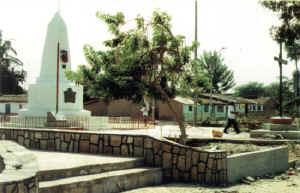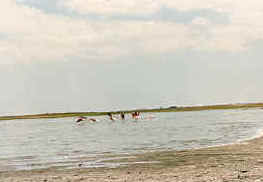MARCAVELICA - PLAZA
|
|
Plaza actual de Tangarará |
|
HERMOSOS FLAMENCOS, DE ALAS ROJAS Y CUERPO BLANCO EN EL ESTUARIO DE TANGARARA
BEAUTIFUL FLAMINGOS, OF RED WINGS AND SCHÖNE FLAMINGOS, VON ROTEN FLÜGELN UND |
|
|
TANGARARÁ
Cuando Pizarro llega a los dominios del cacique Tangac Arac, a orillas del Chira a 15 kms. de Sullana, funda la primera ciudad con el nombre de San Miguel, probablemente, el 15 de agosto de 1532. El rey Carlos V desde Valladolid, el 7 de diciembre de 1537 le otorgó el escudo de armas. La belleza del paisaje que rodea Tangarará es indescriptible. Es un rincón pintoresco. La plaza, de arquitectura moderna, contrasta con las mil historias que guarda el legendario lugar con sus ranchitos de paredes de adobe y techo de paja con barro... es como si el tiempo se hubiera detenido... En la plaza hay un obelisco, construido por el escultor Luis Agurto Coloma en 1932, conmemorando los 400 ańos de fundación y cerca, una réplica de la cruz que utilizara Pizarro para el acto de fundación. Frente a la plaza está el templo, probablemente construido en el mismo lugar donde el cura Valverde oficiara la primera misa. A la ciudad de San Miguel de Tangarará fundada por Pizarro no hay que confundirla con San Miguel del Villar, actual Piura. |
TANGARARÁ |
TANGARARÁ Wenn Pizarro zu Domänen Tangac Arac des cacique 's, neben dem Chira zu 15 kms, ankommt. von Sullana, Fall die erste Stadt mit San Miguel Namen wahrscheinlich August 15 1532. Der König Carlos V von Valladolid, Dezember 7 1537 gewährte ihm das Wappen. Die Schönheit von der Landschaft, die Tangarará umgibt, ist unbeschreiblich. Es ist eine malerische Ecke. Das Quadrat, von moderner Architektur, Kontraste mit das ein tausend Geschichten, die der legendären Stelle mit seinen Ranchs von adobe-Mauern und Stroh-Dach mit Schlamm leistet,... es ist, als ob die Zeit gehalten hatte,... Im Quadrat gibt es einen Stiel, baute vom Bildhauer Luis Agurto Coloma in 1932 und feierte die 400 Jahre Fundament, und es ficht, eine Nachbildung vom Kreuz, das Pizarro für die Fundament-Tat benutzte. Der Tempel ist vor dem Quadrat, das wahrscheinlich in der gleichen Stelle gebaut wird, wo der Priester Valverde die erste Masse fungierte. Zur Stadt von San Miguel von Tangarará geworden von Pizarro gegründet, den es nicht notwendig ist, es mit San Miguel vom Villar zu verwirren, aktueller Piura. |

